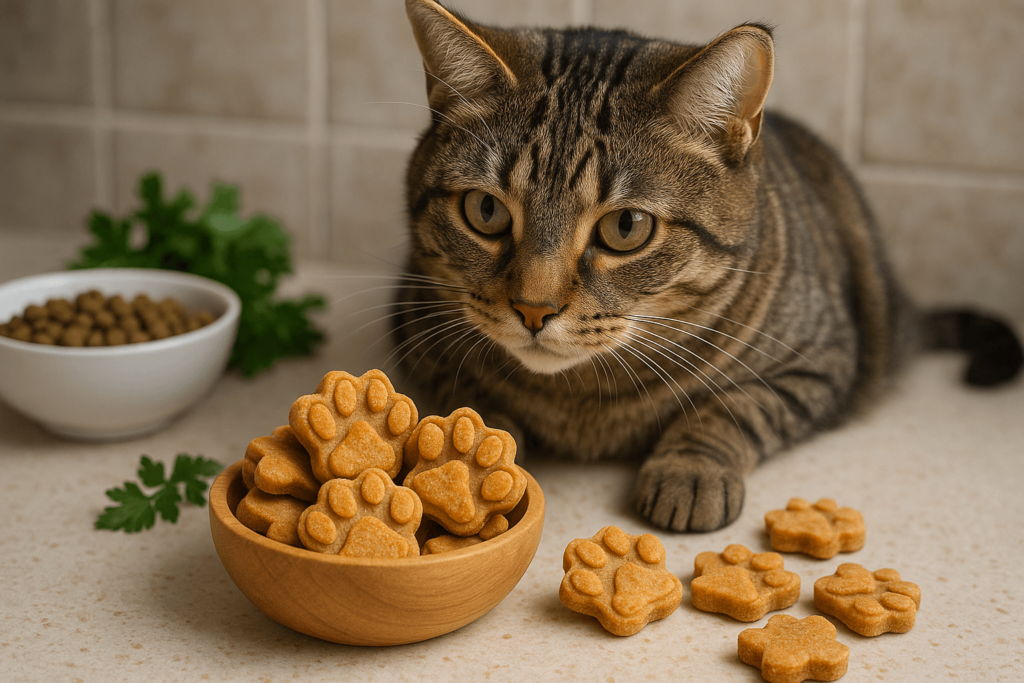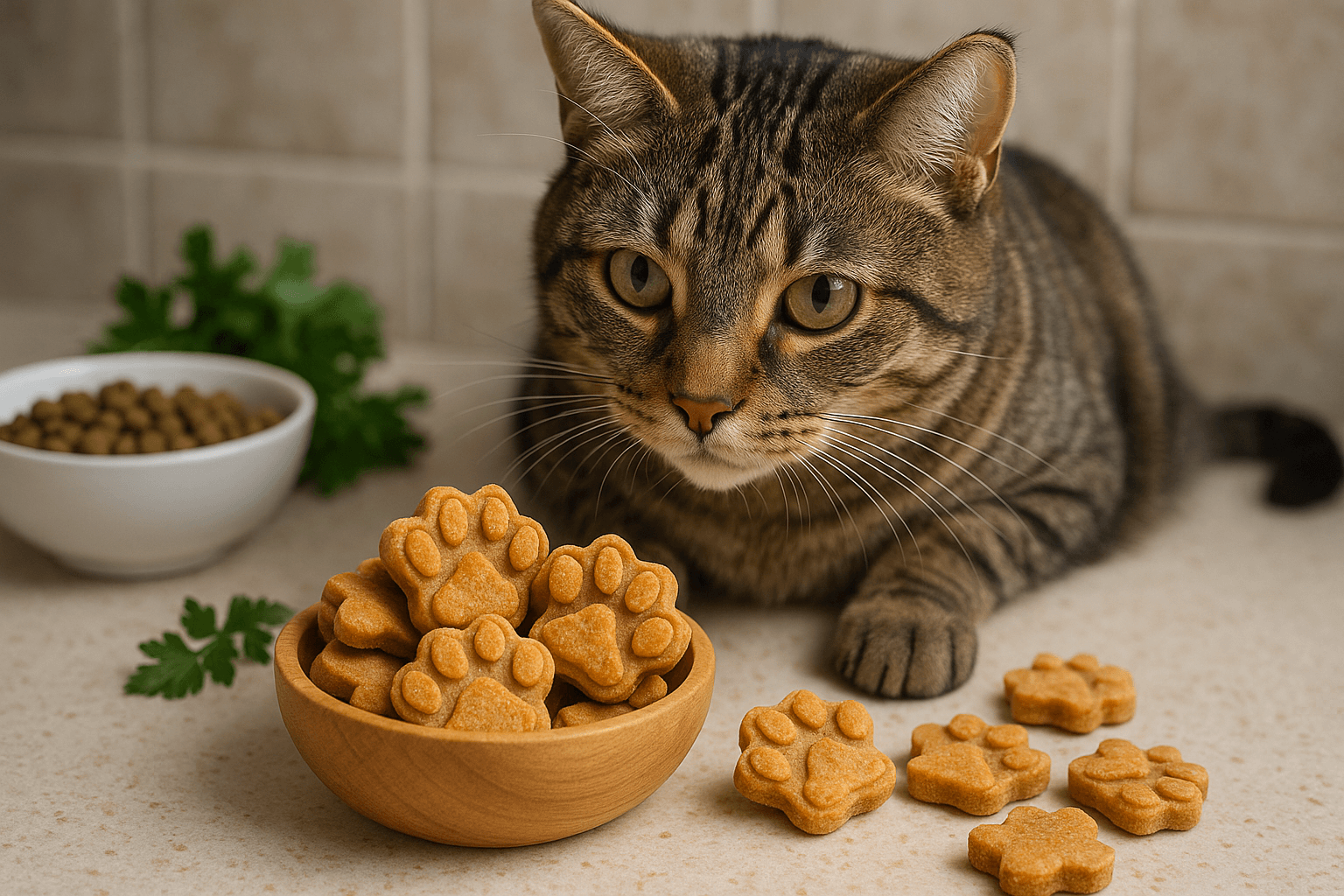Homemade Healthy Cat Treats: Nourish with Love, Not Fillers
Cats are discerning eaters—and their health depends on what’s in their bowl. While store-bought treats are convenient, many are packed with artificial additives, fillers, and low-quality proteins. Homemade healthy cat treats offer a simple, safe, and deeply rewarding alternative. Made with whole, species-appropriate ingredients, these treats support your cat’s vitality, digestion, and even dental health—without the junk. And yes, they’re easier to make than you think.
Why Store-Bought Treats Often Fall Short
Commercial cat treats may look appealing, but their ingredients tell a different story. Most are designed for shelf life, not biological suitability. Here’s why they’re not ideal:
Fillers Like Corn, Wheat, or Soy:
These are cheap, hard-to-digest carbohydrates that cats have no evolutionary need for—and can trigger allergies or weight gain.Artificial Preservatives and Colors:
BHA, BHT, and artificial dyes serve no nutritional purpose and may contribute to long-term health risks.Low Protein Content:
Many treats contain more filler than meat, undermining your cat’s obligate carnivore needs.Excess Sodium or Sugar:
Hidden sugars and salt can strain kidneys and lead to metabolic issues over time.Lack of Transparency:
Ingredient lists are often vague—“meat by-products” doesn’t tell you what’s actually inside.
When you make treats at home, you control every ingredient. No guesswork. No compromises. Just pure, wholesome nutrition tailored to your cat’s biology.

The Health Benefits of Homemade Cat Treats
Making your own treats isn’t just a fun project—it’s a powerful act of preventive care. Here’s how it benefits your cat’s long-term health:
Higher Protein, Lower Carbs:
Homemade recipes use real meat, fish, or organ meats—aligning perfectly with a cat’s natural diet and helping maintain lean muscle mass.No Artificial Additives:
You eliminate preservatives, dyes, and flavor enhancers that can irritate sensitive stomachs or trigger allergies.Customizable for Special Needs:
Whether your cat has kidney disease, food sensitivities, or is overweight, you can tailor recipes to support their condition.Supports Dental Health:
Crunchy, baked treats made with bone meal or fish can help reduce plaque buildup when chewed regularly.Strengthens the Human-Animal Bond:
The time and care you put into making treats builds trust and deepens your connection with your cat.
These aren’t just snacks—they’re tiny acts of love that contribute to a longer, healthier life.
Check this guide 👉Can Cats Eat Dog Treats? Best 7 Expert Tips!
Check this guide 👉How Many Treats Per Day for a Cat? Best 7 Expert Tips!
Check this guide 👉Why Is My Cat Not Eating Food But Eating Treats? Best 7 Tips
| Homemade Treat Advantages | Store-Bought Treat Risks |
|---|---|
| Made with human-grade, whole-food ingredients | Often contain low-quality meat by-products |
| No artificial preservatives or colors | May include BHA, BHT, or propylene glycol |
| High in animal protein, low in carbs | Often high in fillers like corn gluten or peas |
| Can be customized for allergies or medical needs | Limited options for sensitive or senior cats |
| Promotes bonding and mindful feeding | Designed for mass production, not individual health |
Essential Ingredients for Safe, Nutritious Cat Treats
Not all human foods are safe for cats—and not all “cat-safe” ingredients are beneficial. Here’s what to use (and what to avoid):
Cooked Chicken, Turkey, or Lean Beef:
High-quality animal protein is the foundation. Always cook thoroughly and remove bones, skin, and excess fat.Fish Like Salmon or Tuna (in moderation):
Rich in omega-3s for skin and coat health—but limit to 1–2 times per week to avoid mercury buildup.Egg Yolks (cooked):
Packed with choline and biotin, supporting brain and coat health. Never feed raw eggs due to salmonella risk.Pumpkin Puree (unsweetened):
A fiber-rich addition that aids digestion and helps with hairballs. Use only 100% pure pumpkin, not pie filling.Cat-Safe Herbs Like Catnip or Dried Basil:
Add mild flavor and stimulation—catnip can encourage play and reduce stress.
Avoid: onions, garlic, chives, grapes, raisins, chocolate, xylitol, dairy (in large amounts), and raw meat unless under strict veterinary guidance.
Simple, Beginner-Friendly Homemade Cat Treat Recipes
You don’t need culinary expertise to make healthy treats. Start with these foolproof recipes—each takes under 30 minutes.
Chicken & Pumpkin Bites:
Mix 1 cup cooked, shredded chicken, ¼ cup pumpkin puree, and 1 egg. Roll into tiny balls, flatten slightly, and bake at 350°F (175°C) for 20 minutes. Let cool before serving.Tuna & Egg Morsels:
Combine 1 can (drained) tuna, 1 egg, and 2 tbsp oat flour (gluten-free). Form into small squares and bake at 350°F for 15–18 minutes.Freeze-Dried Liver Treats:
Slice chicken or beef liver into thin strips. Bake at 200°F (95°C) for 3–4 hours until crisp. Store in an airtight container in the fridge.Catnip Oat Crisps:
Mix ½ cup oat flour, ¼ cup water, and 1 tsp dried catnip. Roll thin, cut into shapes, and bake at 325°F for 25 minutes.Salmon & Sweet Potato Puffs:
Mash ½ cup boiled sweet potato with ½ cup mashed salmon and 1 tbsp flaxseed. Form into small patties and bake at 350°F for 20 minutes.
Always let treats cool completely before giving them to your cat. Start with one treat per day to monitor tolerance.
How to Store and Serve Homemade Treats Safely
Homemade treats lack commercial preservatives, so storage matters just as much as preparation.
Refrigerate:
Keep treats in an airtight container in the fridge for up to 5 days.Freeze for Longevity:
Portion and freeze treats in silicone molds or zip-top bags—they last up to 3 months.Label Everything:
Write the date and ingredients on containers to track freshness and avoid repeats if your cat has sensitivities.Serve in Moderation:
Treats should never exceed 10% of your cat’s daily caloric intake. Overfeeding leads to weight gain.Introduce Slowly:
Offer one new treat type at a time. Watch for vomiting, diarrhea, or itching—signs of intolerance.
Proper storage preserves nutrition and prevents spoilage. A well-stored treat is a healthy treat.
Common Mistakes When Making Cat Treats (And How to Avoid Them)
Even well-intentioned owners can make errors that compromise safety or nutrition.
Using Raw Meat Without Proper Handling:
Raw diets carry risks of bacteria like Salmonella or Toxoplasma. If feeding raw, use only high-quality, freeze-treated meat and consult your vet.Adding “Healthy” Human Ingredients That Are Toxic:
Garlic, onions, and avocado—even in small amounts—can be deadly. Always double-check ingredient safety.Making Treats Too Large or Hard:
Cats have small mouths and delicate teeth. Treats should be bite-sized and soft enough to crush gently.Overusing Fish or Liver:
Too much can lead to vitamin A toxicity or mercury poisoning. Rotate protein sources.Ignoring Calorie Counts:
A single homemade treat can be 20–50 calories. For a 10-lb cat, that’s 10–25% of their daily need. Track portions.
The goal isn’t perfection—it’s awareness. Learn from small mistakes and adjust.
When to Consult Your Vet Before Making Homemade Treats
Not all cats are the same. Some have medical conditions that require strict dietary control.
Chronic Kidney Disease:
Low phosphorus and high-quality protein are critical. Avoid high-phosphorus ingredients like dairy or certain fish.Diabetes:
Treats must be ultra-low in carbs. Skip sweet potatoes, pumpkin, or oats if your cat is insulin-dependent.Food Allergies:
If your cat is allergic to chicken or fish, substitute with duck, rabbit, or venison.Hyperthyroidism:
Iodine levels matter. Avoid seaweed or iodized salt. Stick to plain meats.Pancreatitis or GI Sensitivities:
Use lean proteins only. Avoid fats, oils, and dairy entirely.
Your vet can help you formulate safe, therapeutic recipes tailored to your cat’s specific needs.
FAQ: Homemade Healthy Cat Treats
Can I give my cat homemade treats every day?
Yes—but limit them to 1–2 small treats per day, and make sure they account for no more than 10% of total daily calories.
Are homemade treats cheaper than store-bought?
Often yes. A batch of 20–30 treats costs under $2 in ingredients—far less than premium commercial treats.
Can I use tuna packed in oil?
No. Always use tuna packed in water. Oil adds unhealthy fats and can cause digestive upset.
How do I know if my cat likes the treats?
Watch for eager eating, tail flicks, or purring. If they turn away or sniff and leave it, try a different recipe.
Can I make treats for kittens?
Yes—but use softer textures and smaller portions. Avoid hard, crunchy treats until they’re at least 6 months old.
Feed with Intention—Because They Deserve More Than Fillers
Homemade healthy cat treats aren’t just a trend—they’re a return to what cats were meant to eat. Real meat. Simple ingredients. No mystery additives. No corporate shortcuts. When you make treats for your cat, you’re not baking snacks—you’re crafting moments of care. You’re choosing quality over convenience. You’re saying, “I see you. I honor your biology.”
And in the quiet moments—when your cat nudges your hand for just one more bite—you’ll know: this is more than food.
It’s love, served in tiny, delicious pieces.
Canned Pumpkin for Cat Diarrhea: Best 7 Expert Tips! Natural remedy to firm stools, soothe upset bellies, and support gut health safely.
Can a Cat Give You Scabies? Best 7 Expert Tips! Discover the truth about feline mites, human skin risks, and how to protect yourself—without panic.
Cat Flea vs Human Flea: Best 7 Expert Tips! Discover the truth about bites, species, and how to eliminate infestations for good.
Weird Cat Behaviors: Best 7 Expert Tips! Discover why cats do strange things—and how to understand, not punish, their instincts for a happier home.





